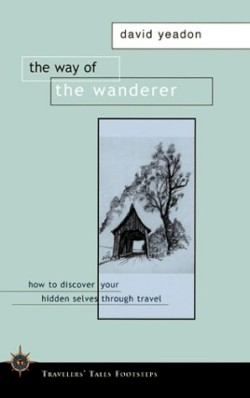The Way of the Wanderer
Discover Your True Self Through Travel
“For some reason I chose travel as my stimulant of choice and catalyst of inner explorations,” writes Yeadon, who delves into both internal and external journeys.
As alluded to in his subtitle (“Discover Your True Self Through Travel,”) Yeadon proposes the idea of the “multi-me,” in which endless versions of inner self reside in the body and can emerge in unusual or challenging situations, oftentimes instigated through travel. Sometimes these variations are complete strangers. He recounts one of his near-death experiences (launched by the line “Things became a little clearer while drowning,”) in which four distinct selves emerged. These were the “dour doomsayer” convinced of death, the “indifferent projectionist” replaying poignant memory-images, the writer-journalist gushing into the tale’s potential, and finally a less familiar self—that rooted in a deep calmness. For Yeadon the process of confronting his “multi-mes” parallels encountering other people. “I find inevitably that I naturally embrace far more readily the multihued dimensions of other people I meet or new situations in which I find my-selves.”
Within his twenty-five plus years of experience (as an author, illustrator, journalist, and photographer), Yeadon’s body of work includes more than twenty travel books as well as an impressive collection of feature travel writing in such publications as National Geographic, National Geographic Traveler, The Washington Post, and The New York Times. His proclaimed area of expertise highlights “hidden corner and backroad exploration,” apparent within this collection of stories. Its format loosely resembles that of a journal and creatively includes drawings, sketches, quotes, the jotting of ideas, and snippets of overheard conversations. This is a relaxed brand of travel writing, almost grass roots in its reverence for the common people, and makes for agreeable reading.
Ultimately The Way of the Wanderer tells stories, and captivating ones at that. The first story sets a tone for the entire book and Yeadon’s “live life fully” mantra. In “Almost Gone #1” he and his wife are driving through the old roads in Iran’s Elburz Mountains, when they begin to cross a one-lane bridge, with no walls to buffer the straight plummet into the ravine some 300 feet below. As they pick up speed a giant truck suddenly appears to be headed straight for them, both vehicles unable to break due to inertia. After momentarily accepting the inevitability of death, Yeadon awakes at the wheel of his car as it slowly coasts down the center of the bridge. There’s no sign or sound of the truck anywhere regardless of the fact that they both heard and saw its evidence. Yeadon bows to the eeriness and power of this encounter, suggesting that perhaps they lost their old selves and emerged as new ones. Written in a succinct and subtle style, this tale previews the reoccurring themes of mysticism and inexplicable yet significant life events.
Also prominent within his stories are the initiation and development of his relationships with strangers. Oftentimes these fortuitous unions lead to overwhelming acts of kindness. For example when Yeadon’s camper breaks down in rural Italy, the gesture of assistance shown by one passerby snowballs into a series of selfless acts shown by the local mechanic, the baker, the pharmacists, and the regional bocci champion. An entire community joyously receives Yeadon’s unplanned and unannounced arrival on a picturesque island, and offers him his own house along with whole-hearted and seemingly endless festivities. A small child saves his life with a plate of fruit and a Coke in the winsomely written “I Am Bananas.”
Many characters are met in this recommended collection. Sometimes they are loners (the recluse living on an island off of Maine), sometimes they are groups of people (an intriguing crew of Hell’s Angels), and sometimes they are internal variations of the author’s self. Their portrayals, along with those of various landscapes and places, are insightful, pleasurable, and unobtrusively bound together with a spiritual thread that pays homage to “The Creator” as well as the exploration of the “infinite array of selves, deep within.”
Reviewed by
Kyle Norris
Disclosure: This article is not an endorsement, but a review. The publisher of this book provided free copies of the book to have their book reviewed by a professional reviewer. No fee was paid by the publisher for this review. Foreword Reviews only recommends books that we love. Foreword Magazine, Inc. is disclosing this in accordance with the Federal Trade Commission’s 16 CFR, Part 255.

